| Listing 1 - 10 of 37 | << page >> |
Sort by
|
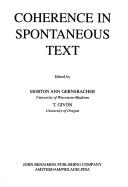
ISBN: 9027229236 1556196377 9786613312648 1283312646 9027276358 9789027276353 9781283312646 6613312649 9781556196379 1556196385 9781556196386 9027229244 9789027229236 Year: 1995 Publisher: Amsterdam Philadelphia J. Benjamins
Abstract | Keywords | Export | Availability | Bookmark
 Loading...
Loading...Choose an application
- Reference Manager
- EndNote
- RefWorks (Direct export to RefWorks)
The main theme running through this volume is that coherence is a mental phenomenon rather than a property of the spoken or written text, or of the social situation. Coherence emerges during speech production-and-comprehension, allowing the speech receiver to form roughly the same episodic representation as the speech producer had in mind. In producing and comprehending a text, be it spoken or written, the interlocutors collaborate towards coherence. They negotiate for a common ground of shared topicality, reference and thematic structure - thus toward a similar mental rep
Discourse analysis --- Congresses --- Cohesion (Linguistics) --- Coherence (Linguistics) --- Cohesiveness (Linguistics) --- Linguistics
Book
Year: 1918 Publisher: Wien Anthropologische Gesellschaft
Abstract | Keywords | Export | Availability | Bookmark
 Loading...
Loading...Choose an application
- Reference Manager
- EndNote
- RefWorks (Direct export to RefWorks)
Anthropology --- Culture diffusion --- Cultural history --- Convergence --- Cohesion (Linguistics)
Book
ISBN: 9789049614607 Year: 2016 Publisher: Brugge Vanden Broele
Abstract | Keywords | Export | Availability | Bookmark
 Loading...
Loading...Choose an application
- Reference Manager
- EndNote
- RefWorks (Direct export to RefWorks)
Een goede professionele tekst is uitnodigend, snel to the point, en treft effectief doel. Alleen: een goede professionele tekst zet u niet zomaar op papier. Gelukkig brengt het boek “Helder schrijven” u een heel eind in de goede richting. Die handige gids is dan ook op het lijf geschreven van iedereen die soms of regelmatig professionele teksten schrijft. Of het nu om administratieve post, handleidingen, commerciële brieven of webteksten gaat. Taal- en communicatiespecialiste Greet De Baets beschrijft het hele schrijfproces vanuit het enige standpunt dat ertoe doet: dat van de ontvanger. Daarbij ontleedt ze alle belangrijke principes: compacte teksten, actieve taal, positieve formuleringen, eenvoudige woorden en correcte spelling. Kortom, in deze uitgave vindt u: 7 schrijfstappen die leiden tot een logische en goed gestructureerde boodschap. 40 gouden schrijfregels die bijdragen aan een doeltreffende tekst. Talrijke tips voor een heldere en aantrekkelijke stijl. Concrete voorbeelden en checklists om de leerpunten in de praktijk te vertalen. Zowel voor beginnende als voor ervaren tekstschrijvers is “Helder schrijven” een toegankelijk en onmisbaar werkinstrument. Communicatieverantwoordelijke, assistent, vertegenwoordiger, student, zaakvoerder, helpdeskmedewerker of nog journalist: iedereen vindt in deze leidraad de nodige tips en tricks om klare en duidelijke teksten tevoorschijn te toveren.
Cohesie (Taalwetenschap) --- Cohesion (Linguistics) --- Cohesion (Linguistique) --- Samenhang (Taalwetenschap) --- Teksten--Samenhang --- Tekstsamenhang --- Schrijftechnieken. --- Schrijven. --- Written communication --- Handbooks, manuals, etc. --- Authorship --- Science --- Stilistics --- schrijfvaardigheid --- schrijfopdracht --- schriftelijke communicatie --- schrijfstijl

ISSN: 01657763 ISBN: 902723017X 1283092824 9027286027 9786613092823 9789027286024 6613092827 9781283092821 9789027230171 Year: 1989 Volume: 16 Publisher: Amsterdam Philadelphia Benjamins
Abstract | Keywords | Export | Availability | Bookmark
 Loading...
Loading...Choose an application
- Reference Manager
- EndNote
- RefWorks (Direct export to RefWorks)
The 35 papers in this volume provide a comprehensive picture of crucial aspects of connectedness. The papers are divided into three main groups: the papers in the first group deal with particular questions of the text-constituting role of anaphora, deixis, coreference, modality, conjunctions and particles, theme, topic, ellipsis, etc., the second group of papers discusses the connectedness in texts/discourses of different types (narrative texts, stories, horoscopes, anecdotes, poems, comics, etc.), and, finally, the papers in the third group discuss general theoretical/methodological questions
Cohesion (Linguistics) --- Congresses. --- Linguistics --- Pragmatics --- -Coherence (Linguistics) --- Cohesiveness (Linguistics) --- Discourse analysis --- Congresses --- Cohérence discursive --- Congrès --- Coherence (Linguistics)
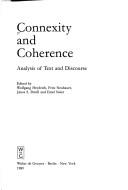
ISSN: 01794167 01794167 ISBN: 3110111020 311085483X 9783110854831 9783110111026 0899253024 9780899253022 Year: 1989 Volume: 12 Publisher: Berlin: Walter de Gruyter,
Abstract | Keywords | Export | Availability | Bookmark
 Loading...
Loading...Choose an application
- Reference Manager
- EndNote
- RefWorks (Direct export to RefWorks)
No detailed description available for "Connexity and Coherence".
Cohesion (Linguistics) --- Coherence (Linguistics) --- Cohesiveness (Linguistics) --- -Cohesion (Linguistics) --- Cohérence discursive --- 82.07 --- Discourse analysis --- Discourse grammar --- Text grammar --- 82.07 Literatuur: verklaring van teksten --- Literatuur: verklaring van teksten --- Congresses --- Discourse analysis. --- Semantics --- Semiotics --- Linguistics --- Pragmatics --- Congresses. --- Cohesion (Linguistics). --- Analyse du discours --- Addresses, essays, lectures
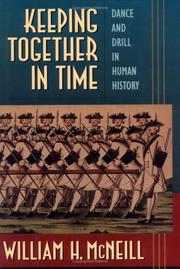
ISBN: 0674502299 9780674502291 9780674040878 0674040872 9780674502307 0674266064 0674502302 Year: 1995 Publisher: Cambridge, Ma : Harvard University Press,
Abstract | Keywords | Export | Availability | Bookmark
 Loading...
Loading...Choose an application
- Reference Manager
- EndNote
- RefWorks (Direct export to RefWorks)
Could something as simple and seemingly natural as falling into step have marked us for evolutionary success? In Keeping Together in Time one of the most widely read and respected historians in America pursues the possibility that coordinated rhythmic movement--and the shared feelings it evokes--has been a powerful force in holding human groups together. As he has done for historical phenomena as diverse as warfare, plague, and the pursuit of power, William McNeill brings a dazzling breadth and depth of knowledge to his study of dance and drill in human history. From the records of distant and ancient peoples to the latest findings of the life sciences, he discovers evidence that rhythmic movement has played a profound role in creating and sustaining human communities. The behavior of chimpanzees, festival village dances, the close-order drill of early modern Europe, the ecstatic dance-trances of shamans and dervishes, the goose-stepping Nazi formations, the morning exercises of factory workers in Japan--all these and many more figure in the bold picture McNeill draws. A sense of community is the key, and shared movement, whether dance or military drill, is its mainspring. McNeill focuses on the visceral and emotional sensations such movement arouses, particularly the euphoric fellow-feeling he calls "muscular bonding." These sensations, he suggests, endow groups with a capacity for cooperation, which in turn improves their chance of survival. A tour de force of imagination and scholarship, Keeping Together in Time reveals the muscular, rhythmic dimension of human solidarity. Its lessons will serve us well as we contemplate the future of the human community and of our various local communities. Table of Contents: Muscular Bonding Human Evolution Small Communities Religious Ceremonies Politics and War Conclusion Notes Index Reviews of this book: "In his imaginative and provocative book. William H. McNeill develops an unconventional notion that, he observes, is 'simplicity itself.' He maintains that people who move together to the same beat tend to bond and thus that communal dance and drill alter human feelings." --John Mueller, New York Times Book Review "Every now and then, a slender, graceful, unassuming little volume modestly proposes a radical rethinking of human history. Such a book is Keeping Together in Time. Important, witty, and thoroughly approachable, [it] could, perhaps, only be written by a scholar in retirement with a lifetime's interdisciplinary reading to ponder, the imagination to conceive unanswerable questions, and the courage, in this age of over-speculation, to speculate in areas where certainty is impossible. Its vision of dance as a shaper of evolution, a perpetually sustainable and sustaining resource, would crown anyone's career." --Penelope Reed Doob, Toronto Globe and Mail "McNeill is one of our greatest living historians. As usual with McNeill, Keeping Together in Time contains a wonderfully broad survey of practices in other times and places. There are the Greeks, who invented the flute-accompanied phalanx, and the Romans, who invented calling cadence while marching. There are the Shakers, who combined worship and dancing, and the Mormons, who carefully separated the functions but who prospered at least as much on the strength of their dancing as their Sunday morning worship." --David Warsh, Boston Sunday Globe "[A] wide-ranging and thought-provoking book.A mind-stretching exploration of the thesis that `keeping together in time'--army drill, village dances, and the like--consolidates group solidarity by making us feel good about ourselves and the group and thus was critical for social cohesion and group survival in the past." --Virginia Quarterly Review "[This book is] nothing less than a survey of the historical impact of shared rhythmic motion from the paleolithic to the present, an impact that [McNeill] finds surprisingly significant. McNeill moves beyond Durkheim in noting that in complex societies divided by social class muscular bonding may be the medium through which discontented and oppressed groups can gain the solidarity necessary for challenging the existing social order." --Robert N. Bellah, Commonweal "The title of this fascinating essay contains a pun that sums up its thesis" keeping together in time, or coordinated rhythmic movement and the shared feelings it evokes, has kept human groups together throughout history. Most of McNeill's pioneering study is devoted to the history of communal dancing.[This] volume will appeal equally to scholars and to the general reader." --Doyne Dawson, Military History "As with so many themes [like this one], whether in science or in symphonies, one wonders (in retrospect) why it has not been invented before.[T]he book is fascinating." --K. Kortmulder, Acta Biotheoretica (The Netherlands) "This scholarly and creative exploration of the largely unresearched phenomenon of shared euphoria aroused by unison movement moves across the disciplines of dance, history, sociology, and psychology. Highly recommended." --Choice
Drill and minor tactics --- Geschiedenis [Wereld] --- Histoire militaire --- Histoire universelle --- Krijgsgeschiedenis --- Militaire geschiedenis --- Military drill --- Military history --- Minor tacties --- Motor psychology --- Movement [Psychology of ] --- Oorlogsgeschiedenis --- Psychomotor education --- Psychomotoriek --- Psychomotricité --- Universal history --- Wereldgeschiedenis --- World history --- Music --- Rhythm --- Dance --- Movement, Psychology of. --- Musique --- Exercice militaire --- Rhythme --- Danse --- Social aspects --- Aspect social --- Drill and minor tactics. --- Military history. --- Unit cohesion (Military science) --- World history. --- Psychological aspects --- Cross-cultural studies. --- Psychological aspects. --- Unit cohesion (Military science). --- Psychomotricité --- Cross-cultural studies --- Motion --- Psychophysiology --- Motion study --- Movement education --- Muscular sense --- Dances --- Dancing --- Amusements --- Performing arts --- Balls (Parties) --- Eurythmics --- Aesthetics --- Movement, Psychology of --- Poetics --- Cycles --- Movement, Aesthetics of --- Minor tactics --- Soldiers --- Tactics --- Cohesion of units (Military science) --- Cohesiveness (Military science) --- Combat cohesion (Military science) --- Social cohesion, Unit (Military science) --- Unit social cohesion (Military science) --- Military art and science --- Military historiography --- Wars --- Historiography --- History --- Naval history --- Drill
Book
ISBN: 9782874962608 Year: 2013 Publisher: Liège Edi.pro
Abstract | Keywords | Export | Availability | Bookmark
 Loading...
Loading...Choose an application
- Reference Manager
- EndNote
- RefWorks (Direct export to RefWorks)
Personal coaching --- Personal narratives --- coaching et performance --- la spirale dynamique --- l'intimité du coaching --- la cohésion sociale --- l'image des coachs --- morale --- éthique
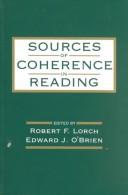
ISBN: 0805816372 080581339X Year: 1995 Publisher: Hillsdale, N. J. ; Hove UK L. Erlbaum Associates
Abstract | Keywords | Export | Availability | Bookmark
 Loading...
Loading...Choose an application
- Reference Manager
- EndNote
- RefWorks (Direct export to RefWorks)
Psycholinguistics --- Pragmatics --- Cohesie (Taalwetenschap) --- Cohesion (Linguistics) --- Cohesion (Linguistique) --- Lecture [Psychologie de la ] --- Lecture--Compréhension --- Leesbegrip --- Lezen [Psychologie van het ] --- Reading [Psychology of ] --- Reading comprehension --- Reading--Comprehension --- Samenhang (Taalwetenschap) --- Teksten--Samenhang --- Tekstsamenhang --- Tekstverstaan --- Reading --- Cohérence discursive --- Compréhension de la lecture --- Lecture --- Psychological aspects --- Aspect psychologique --- Cohérence discursive --- Compréhension de la lecture --- Psychological aspects.

ISBN: 9027228817 0915027860 9027228825 0915027852 9786613092939 9027286272 128309293X 9789027286277 9780915027859 9780915027866 9789027228819 9789027228826 6613092932 9781283092937 Year: 1986 Volume: 11 Publisher: Amsterdam : Benjamins,
Abstract | Keywords | Export | Availability | Bookmark
 Loading...
Loading...Choose an application
- Reference Manager
- EndNote
- RefWorks (Direct export to RefWorks)
This volume seeks to expand our understanding of the relation holding between discourse relations, cognitive units, and linguistic coding. The twenty contributions in this collection explore one or more of the following themes: How point of view, or the salience of information in discourse, affects the organizational coherence of text and discourse; the concept of cognitive and linguistic event and how events are reflected in text and discourse organization; the nature of linguistic coding of events and other kinds of significant information; and the cognitive bases or cognitive correla
801.56 --- Syntaxis. Semantiek --- 801.56 Syntaxis. Semantiek --- Cohesion (Linguistics) -- Congresses. --- Discourse analysis -- Congresses. --- Grammar, Comparative and general -- Syntax -- Congresses. --- Psycholinguistics -- Congresses. --- Cohesion (Linguistics) --- Coherence (Linguistics) --- Cohesiveness (Linguistics) --- Discourse analysis --- Grammar, Comparative and general --- Psycholinguistics --- Linguistics --- Syntax --- Pragmatics --- Congresses --- Grammar [Comparative and general ] --- Philology
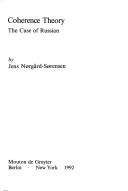
ISBN: 3110129116 3110858681 9783110858686 9783110129113 Year: 1992 Volume: 63 Publisher: Berlin: de Gruyter,
Abstract | Keywords | Export | Availability | Bookmark
 Loading...
Loading...Choose an application
- Reference Manager
- EndNote
- RefWorks (Direct export to RefWorks)
No detailed description available for "Coherence Theory".
Coherence (Linguistics) --- Cohesiveness (Linguistics) --- Speech acts (Linguistics. --- Cohesie (Taalwetenschap) --- Cohesion (Linguistique) --- Samenhang (Taalwetenschap) --- Teksten--Samenhang --- Tekstsamenhang --- Cohérence discursive --- Cohesion (Linguistics) --- Discourse analysis. --- Speech acts (Linguistics) --- Semantics. --- Russian language --- Illocutionary acts (Linguistics) --- Speech act theory (Linguistics) --- Speech events (Linguistics) --- Language and languages --- Linguistics --- Speech --- Discourse grammar --- Text grammar --- Semantics --- Semiotics --- Discourse analysis --- Slavic languages, Eastern --- Formal semantics --- Semasiology --- Semiology (Semantics) --- Comparative linguistics --- Information theory --- Lexicology --- Meaning (Psychology) --- Philosophy --- Lexicology. Semantics --- Pragmatics --- Case studies. --- Cohesion (Linguistics). --- Analyse du discours --- Russe (Langue) --- Sémantique --- Actes de parole --- Case studies --- Cas, Etudes de --- Russian language - Discourse analysis - Case studies. --- Russe (langue) --- Coherence --- Semantique --- Linguistique
| Listing 1 - 10 of 37 | << page >> |
Sort by
|

 Search
Search Feedback
Feedback About UniCat
About UniCat  Help
Help News
News